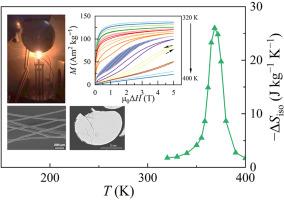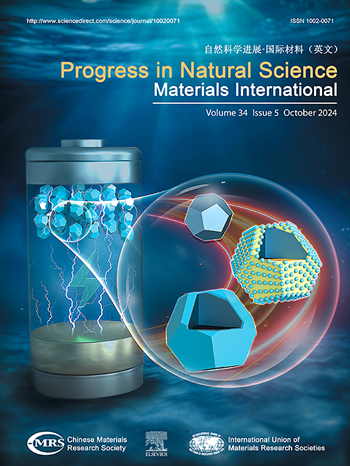金属/非金属比对(MnFe)x(P0.5Si0.5)微丝微结构和磁性能的影响
IF 4.8
2区 材料科学
Q2 MATERIALS SCIENCE, MULTIDISCIPLINARY
Progress in Natural Science: Materials International
Pub Date : 2024-10-01
DOI:10.1016/j.pnsc.2024.08.004
引用次数: 0
摘要
本文研究了金属/非金属比(M/NM = x:1)对经过短时间热处理的有前途的熔融萃取锰-铁-硅微线的微观结构和磁致性能的影响。在低 M/NM 比时,应形成更多的 Fe2P 主相,这被认为是磁致效应(MCE)的最爱,Fe2P 相的比例随着 x 的减小而增加。值得注意的是,金属的缺乏导致热磁滞(Thys)和磁滞损耗(Wy)减少了 ∼40%。磁转变温度(Ttran)、等温磁熵变化峰值(-ΔSisopeak)、制冷剂容量(RC)和有效制冷剂容量(RCE)随着 x 的减小先增大后减小,在 x = 1.90 时达到最大值,即分别为 370 K、26.0 J kg-1 K-1、367.4 和 339.8 J kg-1。因此,通过调节 M/NM 比 x,可有效实现熔融萃取(MnFe)x(P0.5Si0.5)微丝微结构和磁性能的定制,并获得具有新型热磁性能的优化 Mn-Fe-P-Si 复合物。本文章由计算机程序翻译,如有差异,请以英文原文为准。

The effect of metal/non-metal ratio on the microstructure and magnetic properties of (MnFe)x(P0.5Si0.5) microwires
The effects of metal/non-metal ratio (M/NM = x: 1) on the microstructure and magnetocaloric properties of promising melt-extracted Mn–Fe–P–Si microwires with short heat treatment have been investigated here. More Fe2P principal phase, which is considered favorite for magnetocaloric effect (MCE), should achieve at low M/NM ratio and the fraction of Fe2P phase increased with the reduction of x. Meanwhile, the (Mn, Fe)3Si impurity phase is formed for x = 2.00–1.90 whereas change to (Mn, Fe)5Si3 structure for x = 1.85. It's worth noting that a metal deficiency resulted in the thermal hysteresis (Thys) and the magnetic hysteresis loss (Wy) decreased by ∼40 %., The magnetic transition temperature (Ttran), peak value of isothermal magnetic entropy change (−), refrigerant capacity (RC) and effective refrigerant capacity (RCE) first increased then decreased with the decrease of x, and reached the maximums at x = 1.90, i.e., 370 K, 26.0 J kg−1 K−1, 367.4 and 339.8 J kg−1, respectively. Therefore, the customizable microstructure and magnetic properties of the melt-extracted (MnFe)x(P0.5Si0.5) microwires will be achievable effectively by tuning M/NM ratio x, and optimized Mn–Fe–P–Si compounds with novel thermomagnetic properties will be obtained.
求助全文
通过发布文献求助,成功后即可免费获取论文全文。
去求助
来源期刊
CiteScore
8.60
自引率
2.10%
发文量
2812
审稿时长
49 days
期刊介绍:
Progress in Natural Science: Materials International provides scientists and engineers throughout the world with a central vehicle for the exchange and dissemination of basic theoretical studies and applied research of advanced materials. The emphasis is placed on original research, both analytical and experimental, which is of permanent interest to engineers and scientists, covering all aspects of new materials and technologies, such as, energy and environmental materials; advanced structural materials; advanced transportation materials, functional and electronic materials; nano-scale and amorphous materials; health and biological materials; materials modeling and simulation; materials characterization; and so on. The latest research achievements and innovative papers in basic theoretical studies and applied research of material science will be carefully selected and promptly reported. Thus, the aim of this Journal is to serve the global materials science and technology community with the latest research findings.
As a service to readers, an international bibliography of recent publications in advanced materials is published bimonthly.

 求助内容:
求助内容: 应助结果提醒方式:
应助结果提醒方式:


